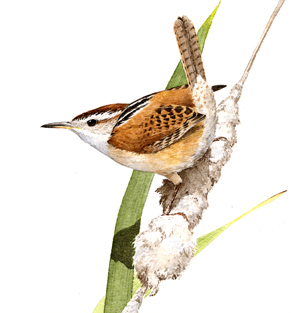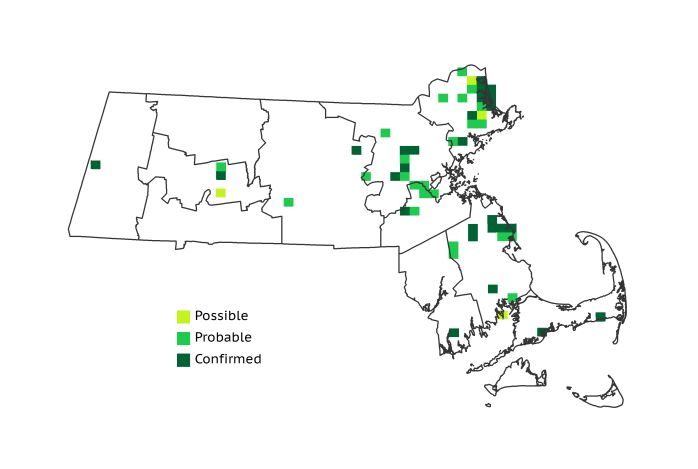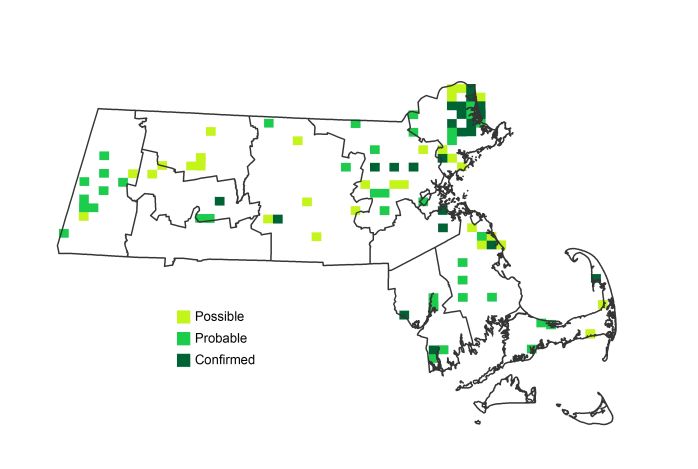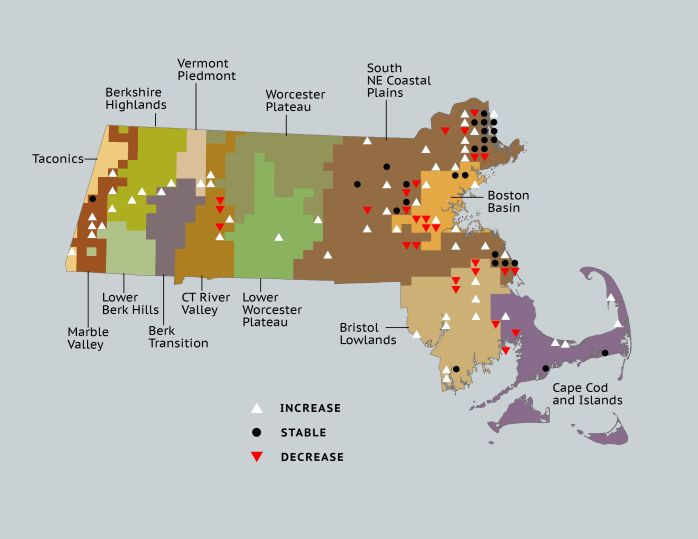Breeding Bird Atlases (BBA)
Find a Bird
Marsh Wren
Cistothorus palustris

Local and likely increasing
“Poets who know no better rhapsodize about the peace of nature, but a well-populated marsh is a cacophony.” – Bern Keating
The cacophony in a well-populated marsh is often due in no small part to the efforts of Marsh Wrens. These boisterous birds regularly fill the air in a cattail marsh with their reedy, gurgling songs. Like many other wrens, the males often build a number of “dummy nests” before the real one is selected, and they sing to attract a female to evaluate their multiple efforts. Marsh Wrens, as their name suggests, depend heavily on marsh habitat. Accordingly, efforts to maintain Massachusetts’ wetlands are crucial to the continued survival of this species.
Historic Status
For many years the species we now call Marsh Wren was known as the Long-billed Marsh Wren, to differentiate it from the Short-billed Marsh Wren, a species today known as the Sedge Wren. To confuse matters more, Massachusetts ornithologists of the 1830s called these two species the Salt-water Marsh Wren and Fresh-water Marsh Wren, respectively (Peabody 1839). The Marsh Wren was verified as a breeder in the state during the 1830s thanks to the discovery of a nest and eggs in Barnstable by Dr. D. Humphries Storer (Peabody 1839). Charles W. Townsend believed the species bred no farther north than Essex County in 1905 (Bent 1948), and he may well have been correct. Breeding records for Maine and New Hampshire were not established until after 1920 (Kroodsma & Verner 1997).
Atlas 1 Distribution
Though often associated with salt marshes, Marsh Wrens could be found in both coastal and inland wetlands in Atlas 1. The westernmost records were few and came from the Marble Valleys and the Connecticut River Valley. The Coastal Plains had the highest percentage of occupied blocks of all the ecoregions at 12%, much of which was concentrated around large wetlands such as Great Meadows National Wildlife Refuge in Concord and Parker River National Wildlife Refuge in Newburyport, and along the North River. Marsh Wren breeding activity was more diffuse but still Confirmed at multiple locations in each of the Bristol/Narragansett Lowlands and the Cape and Islands ecoregions.
Atlas 2 Distribution and Change
The plucky Marsh Wren gained ground during the Atlas interval, increasing from 6% to 9% block occupancy statewide. They were present in each ecoregion in the state, with small but widely distributed gains statewide, although clearly the bulk of their distribution still lay in the Coastal Plains. This region did not have much of an increase in the percent of occupied blocks, however. Their absence from Martha’s Vineyard and Nantucket was notable. The Marble Valleys, Coastal Plains, and Cape Cod hosted most of the net growth in occupied blocks across the state, although each of these regions posted gains in the single digits.
Atlas 1 Map

Atlas 2 Map

Atlas Change Map

Ecoregion Data
Atlas 1 | Atlas 2 | Change | ||||||
Ecoregion | # Blocks | % Blocks | % of Range | # Blocks | % Blocks | % of Range | Change in # Blocks | Change in % Blocks |
Taconic Mountains | 0 | 0.0 | 0.0 | 1 | 4.0 | 1.1 | 1 | 6.7 |
Marble Valleys/Housatonic Valley | 1 | 2.6 | 1.9 | 7 | 17.9 | 7.7 | 6 | 15.4 |
Berkshire Highlands | 0 | 0.0 | 0.0 | 4 | 7.3 | 4.4 | 4 | 7.5 |
Lower Berkshire Hills | 0 | 0.0 | 0.0 | 0 | 0.0 | 0.0 | 0 | 0.0 |
Vermont Piedmont | 0 | 0.0 | 0.0 | 1 | 5.9 | 1.1 | 1 | 8.3 |
Berkshire Transition | 0 | 0.0 | 0.0 | 1 | 2.5 | 1.1 | 1 | 3.2 |
Connecticut River Valley | 3 | 5.4 | 5.6 | 6 | 9.2 | 6.6 | 1 | 2.1 |
Worcester Plateau | 0 | 0.0 | 0.0 | 3 | 3.4 | 3.3 | 1 | 2.1 |
Lower Worcester Plateau | 1 | 1.4 | 1.9 | 2 | 2.5 | 2.2 | 1 | 1.9 |
S. New England Coastal Plains and Hills | 33 | 12.2 | 61.1 | 43 | 15.2 | 47.3 | 6 | 2.7 |
Boston Basin | 6 | 10.7 | 11.1 | 7 | 12.5 | 7.7 | 1 | 1.8 |
Bristol and Narragansett Lowlands | 7 | 6.6 | 13.0 | 9 | 7.9 | 9.9 | 2 | 2.0 |
Cape Cod and Islands | 3 | 2.2 | 5.6 | 7 | 4.9 | 7.7 | 4 | 3.3 |
Statewide Total | 54 | 5.6 | 100.0 | 91 | 8.8 | 100.0 | 29 | 3.5 |
Notes
Rising sea level as a function of global climate change could potentially threaten some of the Marsh Wren’s estuarine breeding habitats in the years ahead.



